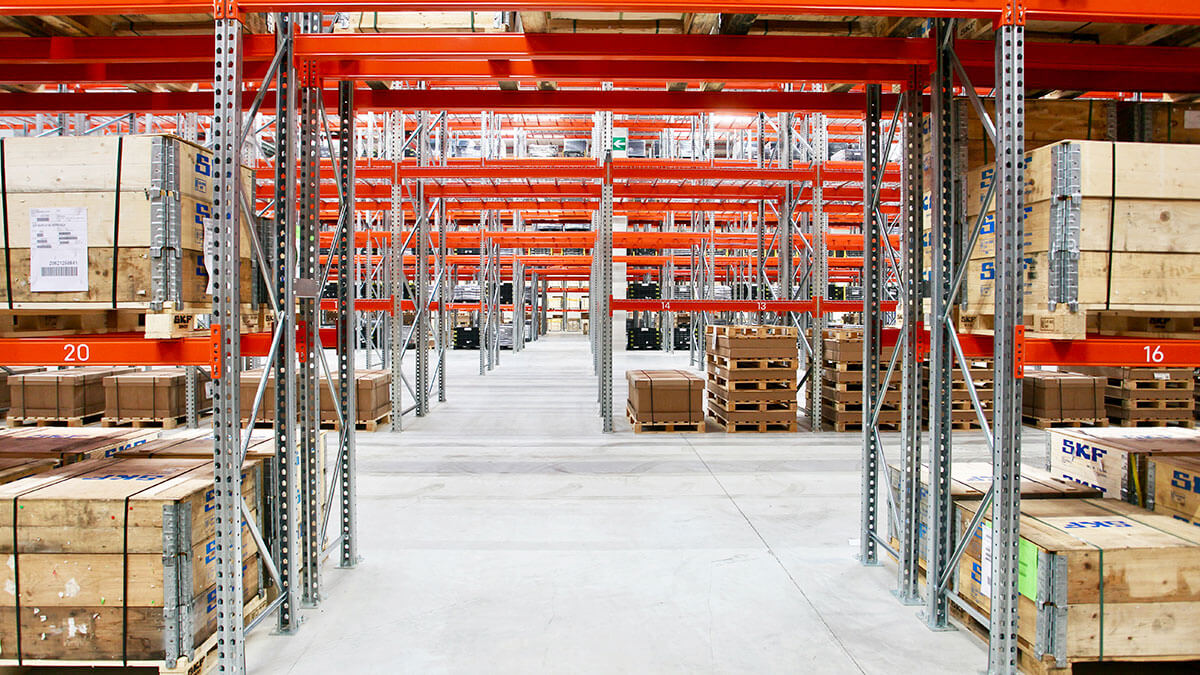
5 Warehouse Storage Types that Offer Efficient Use of Space
April 26, 2023
9 Benefits of Powder Coating Finishes
May 25, 2023There are several storage options available for your warehouse. The right racking system can make it easier to store, pick, and pack your merchandise. So you need to incorporate a rack system that accommodates the type of inventory you store, aligns with your operational goals, and keeps your business profitable.
To help you choose the correct racking system, you need to read this in-depth analysis of different types of warehouse racking systems, their features, and where they can be used.
Types of Warehouse Racking
1. Selective Pallet Rack
A selective racking system allows warehouse employees to select any pallet from the racks without shifting any pallets around. All inventory is stored and picked from the front, therefore offering high selectivity. Moreover, it allows the continuous circulation of your inventory.
Since all pallets can be accessed immediately, forklifts can easily access the inventory. However, this means selective pallet racks must be separated by aisles, so this racking system occupies a considerable amount of floor space and can impact the efficiency of the storage capacity of your warehouse.
A selective pallet racking system is a popular and affordable racking solution for warehouses and distribution centers. It allows employees to store pallets of any shape and size. Plus, it enables them to effortlessly adjust the shelves to accommodate loads of different dimensions.
There are several types of racks, such as structural, roll form, and wire selective pallet racks, to align your warehousing needs.
2. Drive-In Rack
As the name suggests, a drive-in racking system means forklifts can drive into and back out of the aisle from the same place. So it’s a quick way to unload and load merchandise. Moreover, it’s suitable for storing products with long shelf lives as it supports a LIFO (Last In, First Out) inventory management system.
One of the biggest benefits of this type of racking solution is that it is very affordable, and space-efficient since there is no need to leave space for picking aisles. In most warehouses, this type of racking solution allows storage up to six pallets deep. So it is the ideal racking system for small to medium warehouses with large merchandise loads that require high-density storage solutions.
Besides this, since entry and exit are from the same end, the racking system requires less floor space. In fact, it can be installed along the inside perimeter of the warehouse.
However, one drawback of drive-in racking is that it supports LIFO. That means older items can only be accessed when newer merchandise is loaded. Therefore, it offers less selectivity. Moreover, it isn’t a feasible racking solution for businesses that store time-sensitive products. Furthermore, odd-sized stock cannot be stored efficiently in these racks.
3. Drive-Through Racks
Like drive-in racks, drive-through racks eliminate the need for typical work aisles by generating aisles within the racking system. Both warehouse racking types help maximize storage capacity by optimizing the floor space and vertical space of your warehouse.
What makes a drive-through racking system different is that forklifts can enter through both ends of the aisles. One end is designated for loading, while the opposite end is allocated for unloading.
For this reason, it supports a FIFO (First In, First Out) inventory management system. The first pallet to be stored in the aisle is the first one to be used to complete an order. And this makes it an ideal racking solution for those who store perishable items, such as frozen goods, or merchandise that need to be rotated quickly.
However, one drawback of drive-through racking systems is that it requires more floor space than a drive-in system because loading and unloading are completed at opposite ends, and forklifts need extra space to enter and exit the aisles.
4. Cantilever Rack
A cantilever racking system is a storage system that consists of vertical uprights attached to a strong stabilizing base. Arms extend out from the uprights (double-sided or single-sided cantilever systems), allowing inventory to be stored horizontally across these arms.
This type of warehouse racking system is designed for heavy, long, and bulky goods that are difficult to store on typical shelves, such as pipes, lumber, tubes, bars, carpets, etc. And since cantilever racks do not have any vertical structure at the front (e.g., shelves), accessing merchandise is much easier.
In addition to this, a cantilever racking solution offers infinite storage options since the arms can be easily adjusted to align with the requirements (height, width, and capacity) of goods. Moreover, the system can be easily expanded to meet growing storage needs.
Like other types of warehouse racking solutions mentioned so far, it has a few disadvantages too. For starters, this racking system is more expensive than other ones. Furthermore, it requires more floor space since the layout must leave wider aisles to facilitate the movement of large, bulky merchandise.
5. Push Back Racking
Push back racking is a high-density pallet storage solution that uses racks with rollers along inclined rails. So when pallets are loaded onto the racks, it pushes the previous pallet to the back. This means it supports a LIFO inventory management system, making it the ideal warehousing option for homogeneous non-perishable products.
Loading and unloading inventory onto the racks is completed from one spot – the front of the structure. This makes it a very efficient storage solution, supporting the optimization of warehouse storage capacity.
And yes, this racking solution also has a couple of disadvantages. For instance, only pallets at the front of the rack can be accessed, so it may not be suitable for all kinds of merchandise. More importantly, since the system is developed at a slight angle, you are losing some vertical storage height.
Over to You
There are numerous types of warehouse racking solutions. Choosing the right one for your warehouse can boost business productivity, maximize throughput, facilitate inventory management, and make your warehouse more efficient.
A custom warehouse racking system aligns with your warehousing needs and can offer additional benefits to your business. Companies like Midwest Distribution can help create custom shelving and racking systems for your warehouse. With years of experience in supplying steel products to various industries, they can create a variety of custom products, such as carts, racks, wire baskets, containers, etc.
Explore your racking options and then choose the one that contributes to your business’ success.

